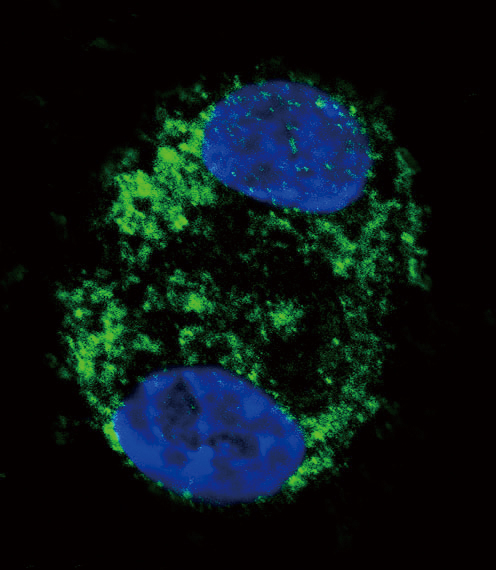CPT2 Antibody (C-term)
Purified Rabbit Polyclonal Antibody (Pab)
- SPECIFICATION
- CITATIONS
- PROTOCOLS
- BACKGROUND

Application
| WB, IF, E |
|---|---|
| Primary Accession | P23786 |
| Reactivity | Human, Mouse |
| Host | Rabbit |
| Clonality | Polyclonal |
| Isotype | Rabbit IgG |
| Calculated MW | 73777 Da |
| Antigen Region | 431-462 aa |
| Gene ID | 1376 |
|---|---|
| Other Names | Carnitine O-palmitoyltransferase 2, mitochondrial, Carnitine palmitoyltransferase II, CPT II, CPT2, CPT1 |
| Target/Specificity | This CPT2 antibody is generated from rabbits immunized with a KLH conjugated synthetic peptide between 431-462 amino acids from the C-terminal region of human CPT2. |
| Dilution | WB~~1:1000 IF~~1:10~50 E~~Use at an assay dependent concentration. |
| Format | Purified polyclonal antibody supplied in PBS with 0.09% (W/V) sodium azide. This antibody is prepared by Saturated Ammonium Sulfate (SAS) precipitation followed by dialysis against PBS. |
| Storage | Maintain refrigerated at 2-8°C for up to 2 weeks. For long term storage store at -20°C in small aliquots to prevent freeze-thaw cycles. |
| Precautions | CPT2 Antibody (C-term) is for research use only and not for use in diagnostic or therapeutic procedures. |
| Name | CPT2 (HGNC:2330) |
|---|---|
| Synonyms | CPT1 |
| Function | Involved in the intramitochondrial synthesis of acylcarnitines from accumulated acyl-CoA metabolites (PubMed:20538056, PubMed:24780397). Reconverts acylcarnitines back into the respective acyl-CoA esters that can then undergo beta-oxidation, an essential step for the mitochondrial uptake of long-chain fatty acids and their subsequent beta-oxidation in the mitochondrion. Active with medium (C8- C12) and long-chain (C14-C18) acyl-CoA esters (PubMed:20538056). |
| Cellular Location | Mitochondrion inner membrane; Peripheral membrane protein; Matrix side |

Thousands of laboratories across the world have published research that depended on the performance of antibodies from Abcepta to advance their research. Check out links to articles that cite our products in major peer-reviewed journals, organized by research category.
info@abcepta.com, and receive a free "I Love Antibodies" mug.
Provided below are standard protocols that you may find useful for product applications.
Background
Carnitine palmitoyltransferase II precursor (CPT2) is a nuclear protein which is transported to the mitochondrial inner membrane. CPT2 together with carnitine palmitoyltransferase I oxidizes long-chain fatty acids in the mitochondria. Defects in this gene are associated with mitochondrial long-chain fatty-acid (LCFA) oxidation disorders.
References
Deschauer, M., et al., Mol. Genet. Metab. 75(2):181-185 (2002).
Haap, M., et al., J. Clin. Endocrinol. Metab. 87(5):2139-2143 (2002).
Britton, C.H., et al., Proc. Natl. Acad. Sci. U.S.A. 92(6):1984-1988 (1995).
Verderio, E., et al., Hum. Mol. Genet. 4(1):19-29 (1995).
Montermini, L., et al., Biochim. Biophys. Acta 1219(1):237-240 (1994).
If you have used an Abcepta product and would like to share how it has performed, please click on the "Submit Review" button and provide the requested information. Our staff will examine and post your review and contact you if needed.
If you have any additional inquiries please email technical services at tech@abcepta.com.













 Foundational characteristics of cancer include proliferation, angiogenesis, migration, evasion of apoptosis, and cellular immortality. Find key markers for these cellular processes and antibodies to detect them.
Foundational characteristics of cancer include proliferation, angiogenesis, migration, evasion of apoptosis, and cellular immortality. Find key markers for these cellular processes and antibodies to detect them. The SUMOplot™ Analysis Program predicts and scores sumoylation sites in your protein. SUMOylation is a post-translational modification involved in various cellular processes, such as nuclear-cytosolic transport, transcriptional regulation, apoptosis, protein stability, response to stress, and progression through the cell cycle.
The SUMOplot™ Analysis Program predicts and scores sumoylation sites in your protein. SUMOylation is a post-translational modification involved in various cellular processes, such as nuclear-cytosolic transport, transcriptional regulation, apoptosis, protein stability, response to stress, and progression through the cell cycle. The Autophagy Receptor Motif Plotter predicts and scores autophagy receptor binding sites in your protein. Identifying proteins connected to this pathway is critical to understanding the role of autophagy in physiological as well as pathological processes such as development, differentiation, neurodegenerative diseases, stress, infection, and cancer.
The Autophagy Receptor Motif Plotter predicts and scores autophagy receptor binding sites in your protein. Identifying proteins connected to this pathway is critical to understanding the role of autophagy in physiological as well as pathological processes such as development, differentiation, neurodegenerative diseases, stress, infection, and cancer.



